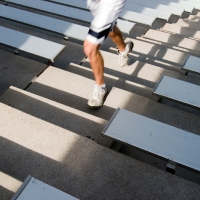 Times may be hard, but experts say finding cost-free ways to get, or stay, fit has never been easier. Just going to the gym is not as important as an active lifestyle,” said Shirley Archer, spokesperson for the American Council on Exercise. “We have to shift that mindset. There are tons of free options.
Times may be hard, but experts say finding cost-free ways to get, or stay, fit has never been easier. Just going to the gym is not as important as an active lifestyle,” said Shirley Archer, spokesperson for the American Council on Exercise. “We have to shift that mindset. There are tons of free options.
Archer, a Florida-based fitness instructor, said studies show that people who go to the gym twice a week but are otherwise inactive, are less fit than people who don’t go to the gym but are routinely active during the day.
“You can start with something as simple as walking,” she said. “Public parks offer organized walking groups. Or start a walking group at your office. You want to be moving at least 150 minutes a week, but that can be broken up into 10 minute bouts.” Volunteerism, Archer said, is a way to follow your passion to cost-free activity.
“If you’re into the environment, you can volunteer to clean up parks and beaches. You can join Habitat for Humanity to help build a house. All require physical activity and you’re contributing something positive.”
Free professionally-led fitness classes have proliferated since the downturn, according to Archer, as private studios seek to attract ever-scarcer dollars and public venues strive to maintain healthy communities.
“Lots of private studios recognize that not everyone can afford to pay and they will offer classes for free or for a contribution,” she said.
Families strapped for cash can apply for membership scholarships at the YMCA, which engages more than 10,000 neighborhoods in the United States.
“The scholarship program is offered every year,” said Katy Leclair, of the Lake View, Chicago, Illinois facility. “It’s income-based and open to all members of the community.”
For those who prefer their communities online, free fitness websites offer workouts, access to fitness experts and daily tips. Changing monthly challenges, such as boot camp exercises or 10-minute workouts, help to keep boredom at bay.
“Our fitness challenges are popular among new members,” said Nicole Nichols of sparkpeople.com, a free, advertiser-supported site which claims 10 million registered members. “We push them with prizes.”
“Realistically, you can set up your own gym at home for less than $50,” she said. “Resistance bands can be had at a yard sale for a couple of dollars. A pedometer is a simple, inexpensive tool to make you realize how much you’re moving.”
Bartering for fitness is another possibility.
Even pricey yoga studios will sometimes trade cleaning chores for studio time.
“I knew someone who worked one or two nights a week at the gym in return for free membership,” Nichols said.
Archer said if after downloading free apps to your smart phone and working out to exercise TV, you still yearn for a fitness center, check online for free trial memberships, which can run to a week or 10 days.

Thanks for sharing. I read many of your blog posts, cool, your blog is very good.
Your point of view caught my eye and was very interesting. Thanks. I have a question for you.
Khám phá thế giới giải trí trực tuyến đỉnh cao tại MM88, nơi mang đến những trải nghiệm cá cược thể thao và casino sống động.
Đến với J88, bạn sẽ được trải nghiệm dịch vụ cá cược chuyên nghiệp cùng hàng ngàn sự kiện khuyến mãi độc quyền.
专业构建与管理谷歌站群网络,助力品牌实现全域流量的强势增长。谷歌站群
Tham gia cộng đồng game thủ tại Go88 để trải nghiệm các trò chơi bài, poker phổ biến nhất hiện nay.
Thanks for sharing. I read many of your blog posts, cool, your blog is very good.
kuwin sở hữu kho game đa dạng từ slot đến trò chơi bài đổi thưởng, mang đến cho bạn những giây phút giải trí tuyệt vời.
采用高效谷歌站群策略,快速提升网站在搜索引擎中的可见性与权重。谷歌站群
Với giao diện mượt mà và ưu đãi hấp dẫn, MM88 là lựa chọn lý tưởng cho các tín đồ giải trí trực tuyến.